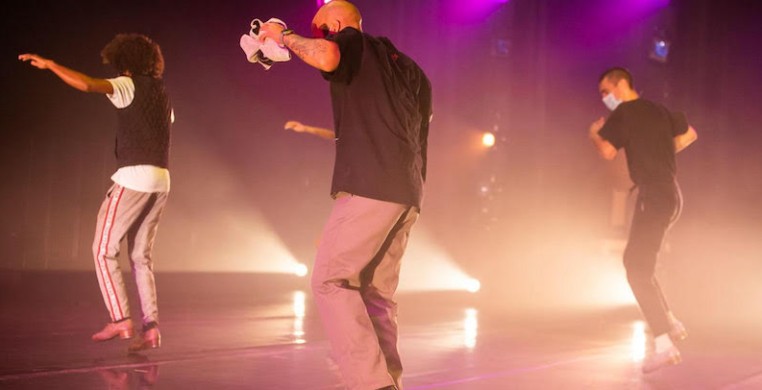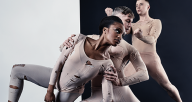This Fall, the Dance Center of Columbia College presents a virtual series called “The Dance Buffet,” a smorgasbord of workshops and performances from over 30 Chicago artists. Tap dancer Jumaane Taylor wants to assault your senses and leave you with a so-bad-it’s-good taste in your mouth with his new work, “Ugly Flavors.” Ironically, it is one of the main offerings in the “dessert” portion of the buffet.
Chicago foodies will tell you that an ambitious palette is the key to enjoying the patchwork of varied cuisines that makes this city one of the culinary hotspots of the 21st century. Taylor asks the same of his audience: that they expand their musical palettes to look past the typical tap dance aural accoutrements like sugar-saturated “Broadway” show tunes or smooth, smoky Jazz standards. Instead, Taylor wants to acquaint you with a more mature, acquired taste. To that end, there are few compositions that rival Igor Stravinsky’s “The Rite of Spring” and Ornette Coleman’s “The Shape of Jazz to Come.”
At the 1913 Paris premiere of “The Rite of Spring," audiences revolted while being pummeled by composer Stravinsky’s orchestral assault—he started with a bassoon, for heaven’s sake—their very souls threatened by dancer Vaslav Nijinsky’s occultist choreography. In 1959, when multi-instrumentalist Coleman released “The Shape of Jazz to Come,” musicians stormed off the stage and refuse to jam with him, citing Coleman’s disinterest in coloring within the lines of harmony and rhythm as being a threat to the very soul of Jazz. Coleman and Stravinsky suffered many detractors and fought back against a backlash of creative prejudice—often coming from other artists. That feeling of being “the outsider” is one with which Taylor empathizes; it is one of the reasons he is drawn to the two controversial compositions.
“It’s hopefully poking at the music and dance scene in the city,” said Taylor in an interview. “The tap dancer can feel like the black sheep in too many circumstances. You can feel like the black sheep in the dance community as well as the black sheep in the Jazz and music communities. Basically, we don’t belong.”
Nestled in the florescent basement of Columbia College Chicago’s Dance Center, Taylor and company—Keyana Latimer, Case Prime and Latrell Garnett—rehearse for their upcoming debut on Nov. 7, voraciously attacking excerpts from the two technically difficult works of music. For “Rite,” the small ensemble slaps some funk on the second movement, “The Augers of Spring,'' by whittling out syncopated niches while maintaining the integrity Stravinksky’s seemingly random accents. In “Shape,” tap dance challenges the music and picks sides, at once teaming up with the driving drum/bass rhythm section against the album’s opening track, “Lonely Woman,” and using the unanchored melody as landmarks to guide them; however, in the following track, “Eventually,” the ensemble flips to team-melody and lets loose with a flurry of fast-feet and bebop-inspired licks and riffs that are set free of the snap-to-grid Western idea of musical meter.
One part I did not see coming was the intro to “Ugly Flavors,” which samples instrumental and spoken-word excerpts from Kanye West’s first fashion show. Let me tell you, I never thought that I would be interested in a Kanye West fashion show, but they are pretty darn interesting. In Taylor’s sample, West even vogues Stravinsky’s aforementioned audacious bassoon introduction that raised such a ruckus in Paris.
Another interesting factoid about “The Shape of Jazz…” is that Coleman used a plastic Grafton saxophone to record his track for “Lonely Woman.” Coleman hated the nasally sound of the instrument at first and only bought because he couldn’t afford a metal saxophone. Taylor similarly is afforded a Marley-covered stage in his residency at the Dance Center. (For dance laymen, “Marley” is the eponymous name for an all-purpose polyvinyl floor covering that is often maligned by tap dancers as it eats up many of the frequencies that give tap dance that warm metal-on-wood sound.)
In this time of COVID-determined performance scheduling, a venue like CCC’s dance department is a pretty sweet gig—Marley notwithstanding—but like Coleman’s squawky plastic sax, Taylor is embracing (for now) the relative pitch-shift of his instrument and is ready to use whatever means are at his disposal.
“I’m listening to everything as an inspirational piece,” said Taylor. “I don’t necessarily go for, 'What would Jumaane say?'. I’m going for, 'What would the tap dancer say?'. It’s re-proclaiming that tap dance can be some form of music. I don’t want to say tap dance ‘is’ music, but tap dance being some type or form of music.”
When I closed my eyes and just listened to the quartet rehearse, I found that the dynamic musicality in Taylor’s choreography suffered little when pit against the synthetic surface of the dance floor. Like Taylor’s previous works—a reimagining of John Coltrane’s “A Love Supreme” and the Free Jazz-inspired collaboration “The Jazz Hoofing Quartet”—he delves head first into some of the most celebrated, complicated and controversial music ever made. “Ugly Flavors” is a vinegary, Russo-American, musical goulash with a souciant treatment of buttery Bebop phrasing and a dose of hot African spice.
I hope that you bring an appetite.
--
“Ugly Flavors” streams Saturday for a one-time-only showing. A donation of $20 for this event will also make available for viewing any of the remaining presentations on the “dessert table” for the “Dance Buffet” event curated by The Dance Center of Columbia College Chicago. For tickets and more information, visit the event page below.


